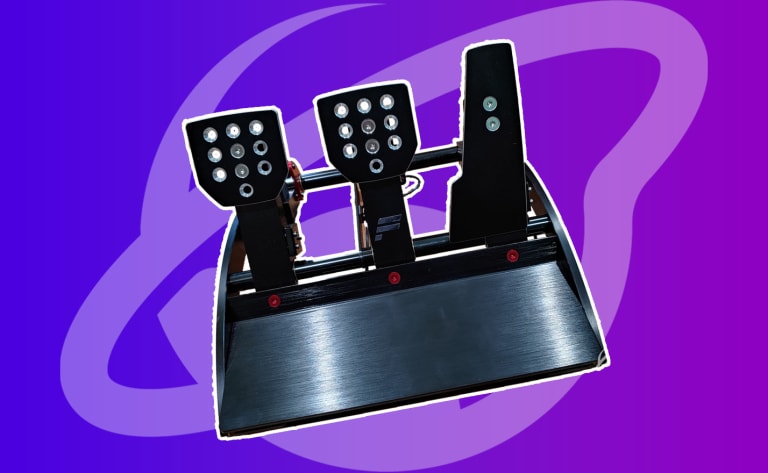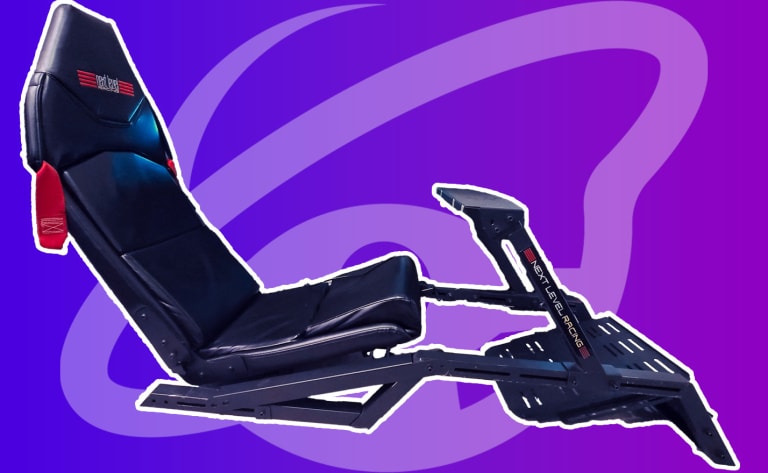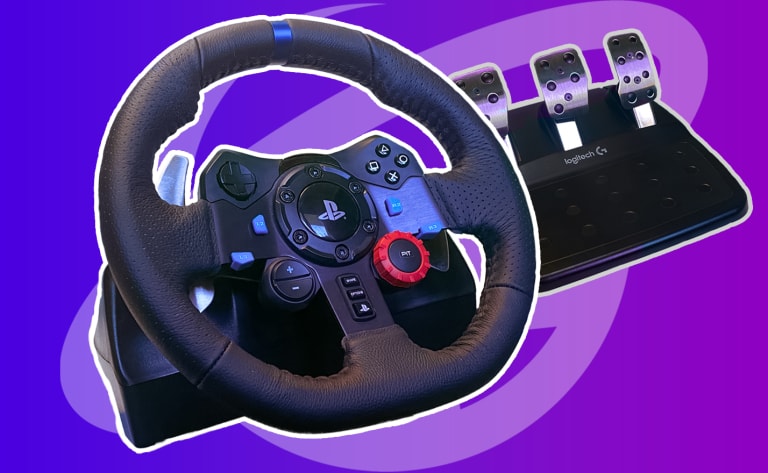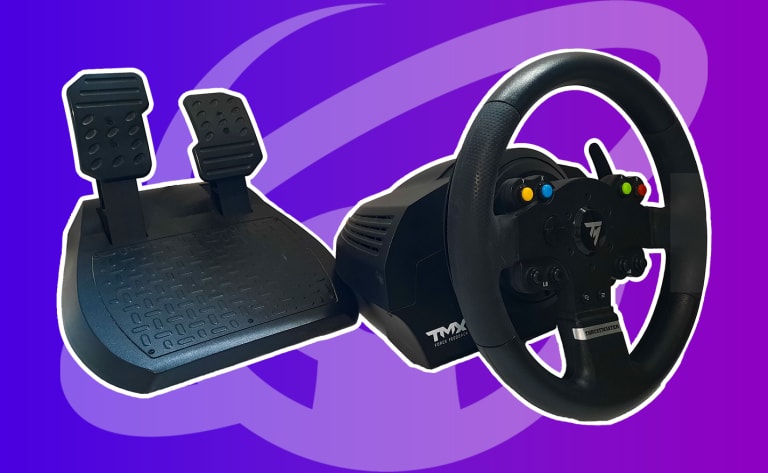Fanatec ClubSport Wheel Base V2.5 Review
Are you looking to upgrade from an entry-level Logitech or Thrustmaster wheelbase? Are you already in, or planning to get into Fanatec’s ecosystem? Then we may have your new wheelbase!
Continue reading to see if the Fanatec ClubSport Wheelbase V2.5 has what it takes to be your new daily driver.
Table of Contents
About the Author
While I'm new to sim racing with a wheel and pedals, I’ve been playing racing games since Pole Position on the Commodore 64.
However, I'm not a hardcore racer. Rather than queuing up in a lobby, most of my time spent sim racing is drifting around a corner or cruising through traffic in Assetto Corsa. For this review, I've also tested F1 2020 using a Fanatec ClubSport Steering Wheel Formula Carbon. ( )
I consider myself a bit of a gear whore. I'm always looking to upgrade and try out new hardware. And, given my use case, my focus is always on value. I don’t go for the cheapest stuff. But I'm not going to spend $50 more on something if I don’t see a notable upgrade.
My current setup is above entry level. It consists of a Logitech G29 wheel, Fanatec CSL Elite Load Cell Pedals, and a generic AliExpress USB shifter and handbrake. I've built myself a rig from wood, and I'm sim racing on a 42-inch LG LCD TV.
About the Wheelbase
Before I get into the review, let’s talk about the different types of wheelbases in the market.
Entry-level wheels, like the Logitech G29, are gear-driven. That means, the wheel is connected to the motor via a gear train which is similar to the transmission in a real car. The gears multiply the torque produced by the motor. However, the gear mesh tends to be noisy, and you can often feel the teeth grating. This is my main problem with the G29.
Mid-level and upper-level bases (like the V2.5) replace the gears with a system of belts. This makes them smoother and quieter to use. However, their downside is that the belts can absorb the feedback transmitted through them. This is due to their flexible construction, rather than a metal gear.
The belts can also stretch or fail over time, depending on how they are designed. Fanatec is a reputable company, so this shouldn’t be a giant concern, but it can’t be overlooked when one is budgeting for purchases of this value.
Upper-level bases have direct drive bases, but those tend to be at the top of the price scale, and are outside the scope of this review.
Initial Impressions
Fanatec's wheelbase products feel well constructed. From the moment you pick it up, you know you’re holding a solid unit. While the base isn’t completely made from metal, there isn’t any cheap or fragile plastic feeling. The plastic there is has a nice rubberized coating, and large, heavy-duty screws are used to hold everything together.
It is important to ensure that your rig is sturdy, as the base weighs around 4.2 kg. It’s also much larger than my current G29, so take that into consideration before into your setup. Currently, it blocks a good portion of the screen on my rig.
The quick release (QR) on the base is metal and the socket contacts are recessed deeply inside. There shouldn’t be any issue with bent pins or broken QR cylinders, that is one of the perks of having a metal base over a plastic one.
The inclusion of a dedicated power button on the front is a pleasant touch. My sim racing computer also pulls double duty as a media server, so it never goes off. That means I have to unplug my G29 at the end of each session.
The LED ring lights also make it effortless to see the power status of the base, without being distracting.
What’s in The Box
The box is nicely packed, and you get Fanatec’s signature reminder that you haven’t purchased a toy.
Besides the base, the box contains a manual, mounting hole drilling template, 20° mounting bracket, power supply and cable, USB cable, and some spare screws and a QR O-ring.
Important reminder: unless you find someone who’s selling you a package deal, the base does not come with an actual wheel. You’ll need to buy that separately. More on that later.
The instruction manual is very thorough and well laid out. You should have no trouble getting it up and running. Speaking of which…
Mounting and Setup
I've mentioned it earlier, you need a sturdy rig to handle this wheelbase. You’re well beyond the point of clamping this thing to a desk (although that would be nice). It requires a well-supported platform that you can drill in. Or, even better, a purpose-built play seat or 8020 rig with a mounting plate.
You’ll also want a comfortable seat with side supports or bolsters. The V2.5 can max out at 8 N-m of torque. A G29 only does 2.2 N-m.
That being said, You definitely want something to hold you in place while you’re flying around a virtual track!
I've chosen to install the included angle mounting bracket to the base. The wheel deck on my rig is angled slightly down to counter the angle of the G29.
The 20° angle of the bracket turned out to be the perfect amount to orient the wheel for a comfortable driving position.
As for actually mounting the base, Fanatec dropped the ball in my opinion. This seems to be a recurring theme with Fanatec products, as the ClubSport Pedals V3 we reviewed were a pain as well.
The drill template is a useful aid, but don’t try to drill the holes while holding the template in place! Instead, mark the mounting piece with a punch and drill from there. Make sure to use an oversized drill bit, since the holes on the base are threaded for M6 screws.
However, your job is far from over. While holding the base in position, you need to go under the rig and try to line up the screw holes, what's worse is there is no visibility from the top side of the mounting surface.
Assuming you drilled your holes in the right spots, or made them large enough to allow for some slop, you can then insert the screws (yay!).
All in all, this was a more tedious process than I expected for a measly four screws.
Another important note, make sure you measure for the correct screw length for your application. Otherwise, you will hit the underside of the base. I, personally, hate designs like this, but we have to make due with what we've got.
Lastly, connect your power and USB cables, slide on and secure your rim, push the start button, and you’re ready to move to the software side of things.
Software Setup
Once you power up the base, Windows should recognize it immediately. Open up the Fanatec Control Panel software. Install any available firmware updates, and make sure it recognizes the base, but don’t make any changes here. Use FanaLab for that.
[photo of Fanatec Control Panel]
In the Tuning Menu within FanaLab, you’re greeted with a multitude of customizable settings for the base!
On their forums, Fanatec offers recommended settings for every sim. The default settings are a good starting point, but don’t be afraid to change things up. I've ended up keeping the recommendations and adjusting depending on the game I'm playing.
[photo of Tuning Menu]
Driving Experience
Once I was done with the settings, I fired up my main sim, Assetto Corsa. Since we were paired with a Formula Carbon rim. That being said, we started with a Corvette C8R around Watkins Glen and were immediately greeted with oscillations that got jarring at high speeds.
After a little research, I ended up having to turn the force feedback within Assetto Corsa down to 40-50%. This made the oscillations more manageable, but still present if you take your hands off the wheel.
Next I tried F1 2020 and the game feels like it was made for this base and rim.
It comes with a configuration for this exact setup, and all the menus can be navigated through without taking your hands off the wheel. Oh, and those oscillations from Assetto Corsa were absent in F1 2020.
The base itself feels incredible! The feedback is buttery smooth and quiet. It’s a night-and-day difference from my G29 that is jerky and grinds. This is an effect that always takes away from the overall immersion of the experience. But it is completely non-existent with the V2.5.
The amount of torque the base produces feels just right. You can get a bit of a workout if you like, without it being overpowered. Or you can dial it back for a bit more relaxed play. The delivery is smooth and fast, this makes driving the car very enjoyable.
I really can’t imagine what some of the more expensive wheels on the market offer, apart from an excessive and unusable amount of torque.
And, in case you were wondering, a DIY wood rig can absolutely be plenty stiff enough to handle the torque produced by the base.
Price Point and competition
The wheelbase costs $550 when purchased new. Now that it's been discontinued, you should have no problem finding it used for around $400. This puts it well-placed between the CSL DD 5 N-m ($350) and the 8 N-m version ($500).
I would personally go for the DD 8 N-m if you've got the budget. If not, and you can find the V2.5 for less than $400, it's a steal.
However, it's not that simple…
Compatibility and the Fanatec Ecosystem
I can’t review a Fanatec wheelbase without mentioning Fanatec's ecosystem and their DRM model.
I mentioned earlier that the wheelbase doesn't come with a rim and that you need to buy it separately.
Fortunately, Fanatec offers a wide variety of rims to pair with the base. Unfortunately, the ones good enough to pair with a higher-end base like this one cost nearly as much as the base itself. And if you want to buy a second to be able to switch from F1/GT to street/drift, you could be looking at anywhere from 50-75% of the price of your whole setup being buried in just your wheel setup.
This is one of the hidden costs of sim racing.
Now, Fanatec does offer universal hubs by themselves so that you can mount your wheel. You can even use the wheel of your real car!
But, again, this doesn't come cheap. Fanatec's universal Podium Hub is $200. Then add in the wheel, paddle shifters, and button modules, and you might as well have just bought a premade solution.
You may be thinking, “why do I even need the hub? I'll just DIY my paddles and buttons.” Well, this is where it gets ugly, my friends.
Fanatec's wheelbases have built-in DRM. This means if you don't connect a Fanatec product to the contacts within the quick release, the base shuts off all force feedback to the wheel.
I warned you, ugly.
And this is why, for as good as the base is, for as good as it feels and responds, I'll end up looking elsewhere for something to replace my vegetable G29. I simply cannot justify the additional costs that come with the Fanatec ecosystem unless I were already invested in it.
Conclusion
Earlier section aside, the base is really great. If you're already in the Fanatec ecosystem, or you're going in eyes open, you absolutely won't be disappointed in the ClubSport Wheelbase V2.5.
It's a sim racer’s dream. Even though it’s discontinued, if you search your local Facebook Marketplace or eBay listings, you should be able to find it for under $400.
At that price, it’s an absolute steal!
Personally, I'm not ready to take that plunge. Instead, I've got my eyes on the Moza R9 direct drive base. It comes with more torque than the V2.5 and none of the DRM nonsense at a price of $450.
Who it’s for:
Anybody looking for a premium wheelbase at a reasonable cost, and is willing to deal with being locked into Fanatec's proprietary ecosystem.
Pros:
- High-quality product
- Plenty of torque
- Smooth and fast delivery
Cons:
- Mounting can be frustrating
- Must be purchased used
- Comes with Fanatec's DRM






